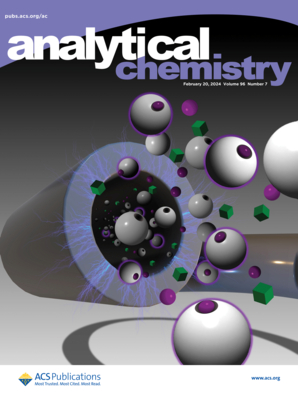"Plasmonic Blackbody" with Broadband Absorption Facilitates Efficient Colorimetric/Fluorescence Dual-Response for Sensitive Bimodal-Type Immunochromatography.
IF 6.7
1区 化学
Q1 CHEMISTRY, ANALYTICAL
引用次数: 0
Abstract
While exploring the physicochemical properties of plasmonic metal nanoparticles provides fascinating optical properties, current research typically ignores the ever-increasing point-of-care (POC) demands with target-dependent dual-response variation and built-in self-calibration function. Herein, we propose utilizing the distinct difference in reduction potential between Au3+/Au0 (1.00 eV) and Pt4+/Pt0 (1.44 eV) for preparing complex 3D highly branched nanostructure as "plasmonic blackbody" with broadband absorption to facilitate efficient colorimetric-fluorescence bimodal-type immunochromatography (ICA). Availing the mesoporous Au@Pt (mAPt) induced minimal scattering section, pronounced broadband absorption with dual-spectral overlap contributed to ∼12.90-fold fluorescence quenching enhancement. Meanwhile, "plasmonic blackbody" spanning the visible region (380-780 nm)-mediated higher contrast combined with larger surface area-induced abundant antibody binding sites resulted in ∼3.125-fold colorimetric response enhancement. By employing ractopamine (RAC) as the model target, this "plasmonic blackbody"-driven colorimetric/fluorescence dual-response platform integrating intensified immuno-recognition demonstrated 0.079 ng mL-1 detection sensitivity in ICA system (∼14.95-fold than classical colloidal gold method). This work showcases the superiority of exploiting physicochemical properties to enhance analytical performance and expands the application scenarios of plasmonic metal nanoparticles.“等离子体黑体”宽带吸收促进高效比色/荧光双响应敏感双峰型免疫层析。
在探索等离子体金属纳米粒子的物理化学性质提供了令人着迷的光学性质的同时,目前的研究通常忽略了日益增长的点护理(POC)需求,其目标依赖的双响应变化和内置的自校准功能。本文提出利用Au3+/Au0 (1.00 eV)和Pt4+/Pt0 (1.44 eV)之间还原电位的明显差异,制备具有宽带吸收的复杂三维高支化纳米结构“等离子体黑体”,以实现高效的比色-荧光双峰型免疫层析(ICA)。利用介孔Au@Pt (mAPt)诱导的最小散射截面,具有双光谱重叠的明显宽带吸收有助于约12.90倍的荧光猝灭增强。同时,跨越可见光区域(380-780 nm)的“等离子体黑体”介导的高对比度结合更大的表面积诱导的丰富抗体结合位点导致比色响应增强约3.125倍。以莱克多巴胺(ractopamine, RAC)为模型靶标,该“等离子体黑体”驱动的比色/荧光双响应平台集成了强化免疫识别,在ICA系统中检测灵敏度为0.079 ng mL-1(比经典胶体金方法高出约14.95倍)。这项工作展示了利用物理化学性质来提高分析性能的优势,扩展了等离子体金属纳米颗粒的应用前景。
本文章由计算机程序翻译,如有差异,请以英文原文为准。
求助全文
约1分钟内获得全文
求助全文
来源期刊

Analytical Chemistry
化学-分析化学
CiteScore
12.10
自引率
12.20%
发文量
1949
审稿时长
1.4 months
期刊介绍:
Analytical Chemistry, a peer-reviewed research journal, focuses on disseminating new and original knowledge across all branches of analytical chemistry. Fundamental articles may explore general principles of chemical measurement science and need not directly address existing or potential analytical methodology. They can be entirely theoretical or report experimental results. Contributions may cover various phases of analytical operations, including sampling, bioanalysis, electrochemistry, mass spectrometry, microscale and nanoscale systems, environmental analysis, separations, spectroscopy, chemical reactions and selectivity, instrumentation, imaging, surface analysis, and data processing. Papers discussing known analytical methods should present a significant, original application of the method, a notable improvement, or results on an important analyte.
 求助内容:
求助内容: 应助结果提醒方式:
应助结果提醒方式:


